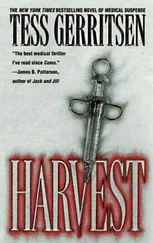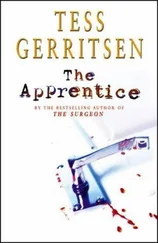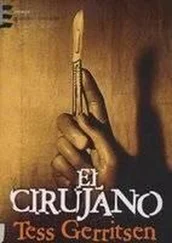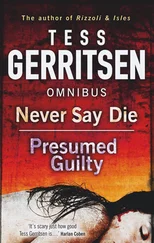By the time he lay her on the kitchen table, she had stopped breathing. Claire gave her three quick breaths, then felt for a carotid pulse, but could not detect one. “Get an ambulance here now!” she said to Lincoln. Positioning her hands over the girl’s sternum, Claire began chest compressions. The blouse was soaked, and her hands kept slipping as she pumped. Fresh blood seeped through the fabric. She is only seven years old. How much blood can a child lose? How much longer can I keep her brain cells alive?
“Ambulance is on the way!” said Lincoln.
“Okay, I need you to cut off her blouse. We have to see where she’s bleeding.”
Claire paused to give the girl three more breaths. She heard fabric ripping and saw that Lincoln had already bared the girl’s chest.
“Jesus,” he murmured.
Blood dribbled from half a dozen stab wounds.
She placed her hands back on the sternum and resumed cardiac compressions, but with every pump, more blood spilled out of the girl’s body.
A siren wailed closer, and through the kitchen window they saw strobelike flashes of light as the ambulance pulled into the front yard. Two EMTs swept into the house, took one look at the child on the table, and threw open their emergency kit. Claire continued pumping on the chest as the EMTs intubated, inserted an IV, slapped on EKG leads.
“Have we got a rhythm?” Claire asked, holding compressions.
“Rapid sinus tach.”
She heard the whiff, whiff of the blood pressure cuff, then the answer: “Barely palpable at fifty. Ringer’s lacate going wide open in this IV Having trouble getting this second line started.
Another siren screamed into the yard, and more footsteps banged into the house.
Officers Mark Dolan and Pete Sparks crowded into the kitchen. Dolan met Claire’s gaze, and he quickly looked away, sensing her reproach. I told you something was wrong!
“There’s a boy upstairs in the attic,” said Lincoln. “I’ve already got him cuffed. Now we have to find the mother.”
“I’ll check the barn,” said Dolan.
Claire protested, “Faye’s in a wheelchair! She couldn’t get out to the barn.
She’s got to be somewhere in this house.”
Ignoring her, Dolan turned and headed straight out the door.
She focused her attention back on the girl. Now that they were getting a pulse, she could stop pumping on the chest, and she was acutely aware that her hands were sticky with blood. She heard Lincoln and Pete running from room to room in search of Faye, heard the EMT’s radio crackle with questions from the Knox Hospital ER.
“How much blood loss?” It was McNally’s voice on the radio.
“Her clothes are saturated,” answered the EMT “At least six stab wounds to the chest. We’ve got sinus tach at one-sixty BP palpable at fifty. One IV in. We can’t get a second line started.”
“Breathing?”
“No. She’s tubed and we’re bagging her. Dr. Effiot’s here with us.”
“Gordon,” Claire called out. “She needs immediate thoracotomy! Get a surgeon there, and let’s just move her!”
“We’ll be waiting for you.”
Though it took only seconds to transfer the girl into the ambulance, Claire felt as if everything were moving in excruciatingly slow motion. She saw it all through a cloud of panic: the heartbreakingly small body being strapped into the stretcher, the tangle of EKG wires and IV line, the tense faces of the EMTs as they ran the girl down the porch steps and slid her into the ambulance.
Claire and one of the EMTs climbed in beside the girl and the door slammed shut.
She knelt beside the stretcher, bagging the lungs and fighting to keep her balance as they bumped down the Braxton driveway, then swung onto the main road.
On the cardiac monitor, the girl’s heart rhythm stumbled. Two premature ventricular beats. Then three more.
“PVCs,” said the EMT
“Go ahead with the lidocaine.”
The EMT had just started to inject the drug when the ambulance hit a pothole. He sprawled backwards, his arm snagging the IV line. The catheter slid out of the girl’s vein, sending a spray of Ringer’s lactate into Claire’s face.
“Shit, I’ve lost the line!” he said.
An alarm beeped on the monitor. Claire glanced up to see a string of PVCs skipping across the screen. At once she began cardiac compressions. “Hurry with that second line!”
Already he was ripping open a package, pulling out a fresh catheter. He tied a tourniquet on Kitty’s arm and slapped the flesh a few times, trying to get a vein to plump up. “I can’t find one! She’s lost too much blood.”
The girl was in shock. Her veins had collapsed.
The alarm squealed. Ventricular tachycardia was racing across the screen.
In panic, Claire gave Kitty’s chest a sharp thump. Nothing changed. She heard the whine of the defibrillator. The EMT had already punched the charge button and was slapping contact pads on Kitty’s chest. Claire pulled away as he positioned the paddles and discharged the current.
On the monitor, the tracing shot up, then slid back to a rapid sinus tachycardia. Both Claire and the EMT released loud sighs of relief.
“That rhythm’s not going to hold,” said Claire. “We need the IV.”
Fighting to keep his balance in the swaying ambulance, he wound the tourniquet around the opposite arm and again searched for a vein. “I can’t find one.”
“Not even the antecubital?”
“It’s already blown. We lost it trying to get the IV started earlier.”
She glanced up at the monitor. PVCs were beginning to march across the screen again. They were still miles away from the ER, and the girl’s rhythm was deteriorating. They had to get an IV in her now.
“Take over CPR,” she said. “I’ll start a subclavian line.” They scrambled to switch positions.
Claire’s heart was hammering as she crouched beside Kitty’s chest and stared down at the collarbone. It had been years since she’d inserted a child’s central venous line. She would have to insert a needle under the clavicle, angling the tip toward the large subclavian vein, while running the danger of puncturing the lung. Her hands were already trembling; in the swaying ambulance, they would be even less steady The girl is in shock, and dying. I have no choice.
She opened the central venous line kit, swabbed the skin with Beta-dine, and snapped on sterile gloves. Then she took a shaky breath. “Hold compressions,” she said. She placed the tip of the needle beneath the collarbone and pierced the skin. With steady pressure she advanced the needle, the whole time gently applying suction to the attached syringe.
Dark blood suddenly flashed back.
“I’m in the vein.”
The alarm squealed. “Hurry! She’s in V. tach!” said the EMT
Lord, don’t send us over a pothole. Not now.
Holding the needle absolutely still, she removed the syringe and threaded the J wire through the hollow needle, into the subclavian vein. Her guide wire was in position; the most delicate part of the procedure was over. Moving swiftly now, she slid the catheter into place, withdrew the wire, and connected the IV tubing.
“Good show, doc!”
“Lidocaine’s going in. Ringer’s at wide open.” Claire glanced at the monitor.
Still in V. tach. She reached for the paddles, and was just placing them on Kitty’s chest when the EMT said, “Wait.”
She looked at the monitor. The lidocaine was taking effect; the V. tach had stopped.
The abrupt lurch of the braking ambulance alerted them to their arrival. Claire braced herself as the vehicle swung around and backed up into the ER bay.
The door swung open and suddenly McNally and his staff were there, half a dozen pairs of hands reaching to pull the stretcher out of the vehicle.
Читать дальше
Конец ознакомительного отрывка
Купить книгу












